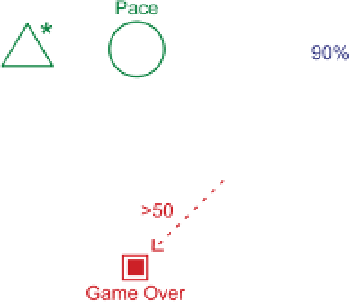Game Development Reference
In-Depth Information
The skill of a player in performing a particular task can also be a decisive factor in
the nature of feedback, as is the case in many computer games. For example,
Tetris
gets more difficult as the blocks pile up, and the rate at which players can get rid
of the blocks is determined by their skill.
Figure 6.29
shows this as an interac-
tive gate that controls a converter. Skillful players will be able to keep up with the
game much longer than players with less skill. Here player skill is a factor on the
operational or tactical level of the game. In games of chance, tactics, or games that
involve only deterministic feedback, a whole set of strategic skills can be quite deci-
sive for the outcome. This feedback loop in
Tetris
is also affected by randomness.
The shape of the block is randomly determined by the game. Although the skill is
generally more decisive in
Tetris
, the player just might get lucky.
FIGURe 6.29
Tetris
usinG nondeterministic symbols
in the machinations tool
You can use the symbols for deterministic behavior in digital machinations diagrams.
if you set the label of a connection to
D,
it will display a dice symbol. The multiplayer
symbol is created by setting the label to
M
, the player skill symbol is created by setting
the label to
S
, and the strategy symbol is created by setting the label to
ST
(for strategy).
Because the machinations Tool cannot actually simulate the effects of player skill or
other players' actions, functionally these symbols all work the same way when the tool
is running: They produce a random value from 1 to 6. By changing the diagram settings,
you can specify other values as you wish. even though they work the same way, Joris
dormans has provided the nondeterministic symbols so that the diagrams are easier to
read. When you see the joystick symbol, you know that it stands for effects influenced by
variations in player skill.






